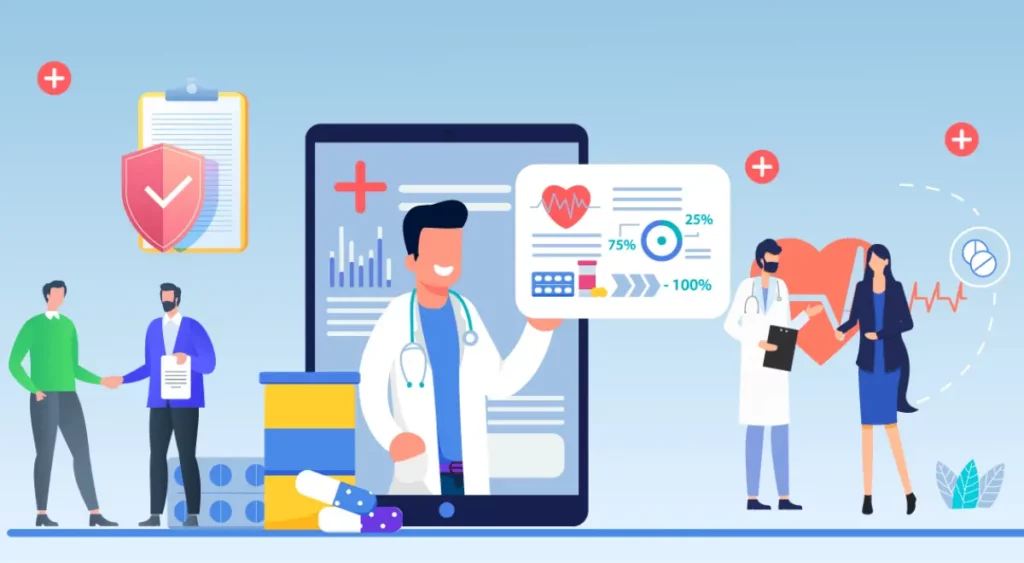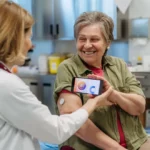Remote Patient Monitoring CMS CPT Codes and Guidelines

Digital health technologies are transforming healthcare, making it more affordable and accessible to people in need of professional medical supervision.
Remote Patient Monitoring (RPM) is a digital technology that monitors and collects medical health data from patients and transfers this information electronically to health specialists for examination.
RPM enables physicians to provide more patient care and supervision than ever before. Tracking analytics assist specialists in understanding what therapy patients are receiving, how they are feeling, and much more about their healthy development.
To maintain better understanding, trust, and customer experience, the Centers for Medicare & Medicaid Services (CMS) has introduced additional remote patient monitoring codes to its Physician Fee Schedule, allowing physicians to be reimbursed for more home-based services.
Let’s move forward with the Remote Patient Monitoring CMS blog to understand everything about remote patient monitoring codes and guidelines in detail.
Table of Contents
ToggleRemote Patient Monitoring CMS Guidelines for Reimbursement
Some suggestions from remote patient monitoring CMS Guidelines to optimize revenue, patient outcomes, and patient experience following CMS RPM reimbursement criteria.
- Billing providers must have had at least one face-to-face interaction with the patient in 12 months.
- Report every 30 days, regardless of the number of metrics analyzed.
- The billing provider must be a Qualified Healthcare Professional(QHCP = MD, DO, NP, PA).
- Suppose two staff members provide services simultaneously (for example, discussing the beneficiary’s condition). In that case, only the time spent by one professional may be counted.
- Time less than 20 minutes in a calendar month cannot be rounded up to fulfill the billing criteria.
- Spare time in one month cannot be carried over to the next.
- Patients on Medicare Part B must pay a co-payment of 20%.
What are Remote Patient Monitoring CPT Codes
The Current Procedural Terminology (CPT) codes provide doctors and other health care workers with a uniform language system for classifying medical treatments to improve reporting effectiveness and precision.
CPT language is the most widely used medical terminology for reporting medical, surgical, laboratory, radiological, anesthesiology, genomic sequencing, (E/M) services covered by public and commercial health insurance systems.
Code Associated with RPM
CMS announced the final regulations for its new Remote Patient Monitoring (RPM) codes, formally named “Remote Medical Monitoring/Treatment Management,” for the Physician Fee Schedule (PFS).
CPT Code 99453 (Initial Set-Up and Monitoring)
- Remote monitoring of physiologic parameters (e.g., weight, blood pressure, pulse rate, respiratory flow rate).
- Initial equipment setup and patient education on equipment use.
CPT Code 99454 (Continued Monitoring Over 16-Days)
- Vital sign monitoring (blood pressure, heart rate, weight, and so on) using an RPM device.
- Initial devices are supplied with daily recordings or programmed alerts transmission.
CPT Code 99457 (Management Services for Initial 20 Minutes)
- When clinical staff/physician/other trained healthcare professionals have to do an interactive communication with the patient/caretaker directly by audio-video call etc.
- Initial 20 minutes of duration tracking to monitor.
CPT Code 99458 (Management Services for Each Additional 20 Minutes)
- 99458 is an add-on to 99457; paid for each additional 20 minutes of RPM every month.
- Professionals cannot invoice the code in isolation; they must always use it in conjunction with 99457.
CPT Code 99091 (Collection and Evaluation of Physiologic Data)
- Data is digitally saved and communicated by the patient or caregiver to the physician or the other QHCP.
- At least 30 minutes every 30 days.
Remote Patient Monitoring CPT Codes: 3 Useful Tips on Using Them
Here are three suggestions for you to use these RPM codes appropriately and obtain further clarity:
- Regardless of the number of devices utilized, a physician can only bill 99454 once per patient per 30 days.
- RPM can be conducted by a billing physician, a qualified healthcare professional (QHCP), or clinical personnel under 99457. Each month, at least 20 minutes of report management time is required.
- A practitioner can bill 99458 per month after charging 99457 for two instances: once at 40 minutes and once at 60 minutes.
Also Read: Remote Blood Pressure Monitoring: A Simple (But Complete) Guide
How Does Remote Patient Monitoring CPT Code and Billing Work?
- Remote monitoring services are available to any Medicare Part B patient.
- RPM is a monthly billable service. For Medicare to reimburse, patients must get at least 20 minutes of service each month.
- Reimbursement is also available for patients’ daily usage of RPM equipment, setup, and training.
- Data must be collected using a Health Insurance Portability and Accountability Act (HIPAA)-compliant resource, such as care management software.
- Remote physiologic monitoring services may be billed by physicians and non-physician practitioners who are eligible to provide evaluation and management services (E/M).
Billing Suggestions for Remote Patient Monitoring
When billing, you will compute the amount of time you spend with each of your patients monthly.
Before billing, you must be aware of the following:
- Each month, ensure that the CMS standards were satisfied for each patient.
- Submit claims to CMS every month.
- Check that no conflicting codes are being billed.
- Ensure that all data is wirelessly synchronized and accessible.
- Data monitoring should be undertaken by a practitioner, a competent healthcare professional, or clinical staff at a single healthcare institution.
- Estimate delivery & rental charges of devices and equipment to the patient for 16 days and how each patient will be able to opt-in to the service.
CMS Remote Patient Monitoring Reimbursement Rates Regarding the Codes
- 99453 – Initial setup of the device – $19.65
- 99454 – Monthly remote monitoring (initial 16 days) – $46.83
- 99457 – Monitoring and treatment management (least 20 min/month) – $48.14
- 99458 – Each additional 20 minutes of monitoring – $38.64
- 99091 – Interpret and process monitoring data – $52.71
Determine the ROI of a Remote Patient Monitoring CMS Program?
The healthcare industry is complex, with each organization differing greatly in operational processes, geographic characteristics, caregiver pools, and patient demographics.
It is essential to cooperate with your RPM partner to set your specific ROI targets and which of your patient demographics will best match the RPM model to determine what sort of ROI you can expect.
Consider the following inquiries:
- What kind of groups do you care about? (Which are the most expensive? Which is the riskiest?)
- What part of your process needs improvement?
- How well do you know the strengths and weaknesses of your current care continuum?
FAQs Related to Remote Patient Monitoring CMS Guidelines & CPT Code
Only physicians or non-physician practitioners authorized to charge Medicare for evaluation and management (E/M) services can order and bill RPM.
CPT codes 99457 and 99458 may be supplied by a physician or other certified healthcare professional and clinical personnel operating under the physician’s overall direction.
In most cases, yes. Patients are responsible for applicable co-pays based on the service received, as with all Medicare treatments. However, during the COVID PHE, clinicians can waive RPM co-pays.
Before or at the start of the service, the practitioner must get the beneficiary’s agreement to receive RPM. This permission must admit that the beneficiary is liable for any copayments or deductibles connected with the treatment. There must be a note of verbal agreement in the medical record.
The most common RPM codes are:
- 99453: Setting up the device for the first time and teaching the patient how to use it. Read more.
- 99454: Providing the device with daily recordings and sending them.
- 99457: The first 20 minutes of clinical staff, physician, or qualified professional time each month for monitoring and managing patient care. Read more.
- 99458: Each extra 20 minutes of RPM services.
- 99091: Getting and understanding physiological data sent digitally by the patient, which takes at least 30 minutes of time from a doctor or qualified health professional each month.
RPM looks at physiological data like weight, blood pressure, glucose, oxygen saturation, and more. RTM, on the other hand, keeps track of non-physiologic data like how well the musculoskeletal system works, how well a patient follows their respiratory therapy, or how much pain they are in. It is often used by non-physician providers like physical therapists.
Yes. RPM can be billed for patients with just one qualifying condition, unlike Chronic Care Management (CCM), which requires two or more chronic conditions. However, device data must be collected and sent for at least 16 days in a 30-day period.
Yes. To charge for 99454, the device must send data on at least 16 of the 30 days in a billing cycle. The claim won’t be paid if this minimum isn’t met.
Yes. The FDA has a definition of a medical device that RPM devices must meet. Wearable tech for consumers, like fitness trackers, usually doesn’t count unless it has been approved by the FDA for medical use.
Yes. CMS has allowed RPM for both new and existing patients since 2021, as long as the clinical documentation and consent are correct.
Doctors, nurse practitioners, physician assistants, and other qualified healthcare professionals can provide RPM services. Depending on state scope-of-practice rules, clinical staff working under general supervision may also be able to provide parts of RPM.
No. CMS only allows a single provider to bill for RPM services for each patient each month. To avoid claim denials, coordination is important.
RPM usually pays more for the first setup and device supply, but you have to keep using the device. CCM pays the same amount for managing two or more chronic conditions, but it doesn’t need device data. Many practices use RPM and CCM to maximize patient care and profits.
Common mistakes are:
- Billing without providing 16 days’ worth of device data.
- Using devices that the FDA hasn’t approved.
- Not having proof of patient consent.
- Charging for RPM and similar services twice in the same month.
Why Choose HealthArc’s RPM
The HealthArc RPM software platform enables physician groups to enhance outcomes for thousands of patients while generating additional revenues.
- One-stop solution for health practitioners to support and improve patient care through RPM.
- Integrates with EHR and connected devices that enable external APIs, including Bluetooth and cellular devices.
- Supports multiple conditions by offering a complete overview of patient clinical data analytics.
- Improves clinical decision support by generating patients’ specific clinical insights and comprehensive health management.
- Maintains high privacy and data security levels by ensuring that all components are HIPAA compliant.
Conclusion
RPM helps healthcare professionals improve health outcomes, lower costs, and increase efficiency, but it demands seamless and strong solutions to achieve superior patient and revenue outcomes.
Schedule a demo today to learn more about billing remote patient monitoring CMS CPT codes.
Most Recent Blogs
Categories
Related Blog
- October 23, 2025 | Read Time: 12 mins
How RPM Devices Improve Hypertension and Diabetes Outcomes in Medicare Populations
Remote patient monitoring (RPM) is transforming chronic care for Medicare beneficiaries. CMS...
Learn More- August 25, 2025 | Read Time: 13 mins
How Can “One Big Beautiful Bill” Boost RPM Programs by $50B?
The “One Big Beautiful Bill,” signed July 4, 2025, directs $50B over...
Learn More- August 22, 2025 | Read Time: 17 mins
HealthArc Platform vs RPM Software Solutions
Is your healthcare organization trying to pick a remote patient monitoring solution?...
Learn More


